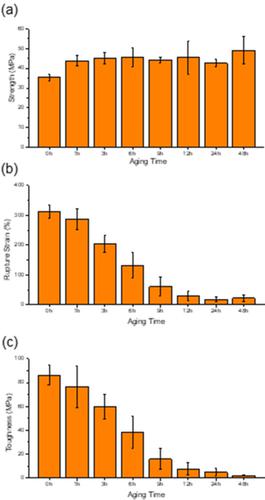当前位置:
X-MOL 学术
›
J. Polym. Sci.
›
论文详情
Our official English website, www.x-mol.net, welcomes your feedback! (Note: you will need to create a separate account there.)
Toughening of poly(lactide acid) with low crystallinity through biaxial poststretching
Journal of Polymer Science ( IF 3.4 ) Pub Date : 2020-11-13 , DOI: 10.1002/pol.20200526 Hongwei Zhou 1 , Zhaoqiang Song 1 , Shengqiang Cai 1, 2
Journal of Polymer Science ( IF 3.4 ) Pub Date : 2020-11-13 , DOI: 10.1002/pol.20200526 Hongwei Zhou 1 , Zhaoqiang Song 1 , Shengqiang Cai 1, 2
Affiliation

|
Poly(lactide acid) (PLA) is an eco‐friendly, biocompatible and biodegradable polymer that has been extensively explored in diverse applications ranging from biomedical devices to food packages. One well‐known limitation of PLA in the applications is its low mechanical toughness and small stretchability. In this work, we have conducted systematic studies of the effects of the thermo‐mechanical processing on the mechanical behaviors of PLA with extremely low crystallinity (less than 3%). It is found that a freshly quenched PLA after hot pressing can be quite stretchable and tough. However, after only 2 days of aging at room temperature, the PLA becomes very brittle. We attribute such aging‐induced ductile‐to‐brittle transition of the PLA to its plastic deformation mode changing from shearing to crazing. To increase the toughness and stability of the PLA, we apply poststretching onto the PLA. Our results have shown that after poststretching, both the toughness and stretchability of aged PLA can be greatly increased. Moreover, the mechanical properties of the PLA after poststretching become more aging resistant.
中文翻译:

通过双轴后拉伸对低结晶度的聚丙交酯酸进行增韧
聚乳酸(PLA)是一种生态友好,生物相容性和可生物降解的聚合物,在从生物医学设备到食品包装的各种应用中都得到了广泛的探索。PLA在应用中的一个众所周知的局限性是其低的机械韧性和小的拉伸性。在这项工作中,我们对热机械加工对结晶度极低(小于3%)的PLA力学行为的影响进行了系统的研究。已经发现,热压后刚淬火的PLA可以相当地拉伸和坚韧。但是,在室温下仅老化2天后,PLA变得非常脆。我们将PLA的这种由老化引起的韧性到脆性转变归因于其塑性变形模式从剪切变为开裂。为了增加PLA的韧性和稳定性,我们将后拉伸应用于PLA上。我们的结果表明,后拉伸后,老化的PLA的韧性和可拉伸性都可以大大提高。而且,PLA的机械性能在后拉伸后变得更耐老化。
更新日期:2020-12-15
中文翻译:

通过双轴后拉伸对低结晶度的聚丙交酯酸进行增韧
聚乳酸(PLA)是一种生态友好,生物相容性和可生物降解的聚合物,在从生物医学设备到食品包装的各种应用中都得到了广泛的探索。PLA在应用中的一个众所周知的局限性是其低的机械韧性和小的拉伸性。在这项工作中,我们对热机械加工对结晶度极低(小于3%)的PLA力学行为的影响进行了系统的研究。已经发现,热压后刚淬火的PLA可以相当地拉伸和坚韧。但是,在室温下仅老化2天后,PLA变得非常脆。我们将PLA的这种由老化引起的韧性到脆性转变归因于其塑性变形模式从剪切变为开裂。为了增加PLA的韧性和稳定性,我们将后拉伸应用于PLA上。我们的结果表明,后拉伸后,老化的PLA的韧性和可拉伸性都可以大大提高。而且,PLA的机械性能在后拉伸后变得更耐老化。


























 京公网安备 11010802027423号
京公网安备 11010802027423号